The latest Closing the Gap report, tabled in federal parliament on Wednesday, shows poor progress on improving the situation of Indigenous Australians on many key indicators.
Only two of the targets set in 2008 by the Council of Australian Governments are on track.
Prime Minister Tony Abbott told parliament that in many respects the report was “profoundly disappointing”, despite the concerted efforts of successive governments.
Declaring that more work was needed, Abbott also urged Aboriginal people to have high expectations for themselves and especially their children in the effort to make greater progress.
There had been some improvements in education and health outcomes, Abbott said, and “we are on track to halve the gap in year 12 attainment rates for [those] aged 20-24”.
The target to halve the gap in mortality rates for Aboriginal and Torres Strait Islander children looked achievable by 2018.
A new target of closing the school attendance gap within five years should be also achievable.
“However, the other targets – to close the gap in life expectancy within a generation; to ensure access to early childhood education for all Aboriginal and Torres Strait Islander four-year-olds in remote areas; to halve the gap in reading and numeracy for Aboriginal and Torres Strait Islander students; and to halve the gaps in employment outcomes – have either not been met or are not on track to be met.”
What had to be changed was entrenched and multigenerational disadvantage.
“This won’t happen overnight and it may not ever happen unless we continue to place high demands on ourselves of what we can achieve together.”
Outlining some success stories, Abbott said that in every community the foundations for success were education, jobs and a safer living environment, underpinned by better health. The key was the practical delivery of programs and policy.
But while government policies could be a catalyst, where success was achieved it was due to Aboriginal and Torres Strait Islander people who wanted better for themselves.
“Governments can fund and governments can urge but governments can’t change attitudes and behaviours. It’s those who make the choice to send their children to school, those who make the choice to attend school and stick to it, those who make the choice to get a job and stick to it and those who choose to abide by the law who are the ones closing the gap.
"Closing the gap is not something granted by this parliament to Indigenous Australians. Closing the gap is to be grasped by them and closing the gap starts with getting the kids to school – and it starts with expecting much of them while they are there.”
Abbott said that while most Indigenous families did make sure their children attended school regularly, “too many are still missing too much school, especially in remote areas”.
Some Coalition MPs walked out when opposition leader Bill Shorten referred to the government’s funding cuts.
Shorten told parliament the Closing the Gap framework stretched beyond the life of any government. “This is an endeavour where every opposition wants the government to succeed,” he said.
“But when a government cuts $500 million from essential services, we are compelled to point out what these cuts mean.”
Vital organisations didn’t know whether their funding would be continued or withdraw. Cuts would mean shelters for those fleeing from violence would be closed; they would rob Indigenous Australians of legal aid; preventive health programs would be hit.
Shorten appealed to the government to reverse the cuts and “seek to repair the harm”.
The Australian Council of Commerce and Industry said businesses, governments and Indigenous people must redouble efforts to improve employment outcomes for Indigenous Australians. “The private sector has a major role to play in providing sustainable employment opportunities for Indigenous Australians rather than jobs that are dependent on government programs.”

